A Novel Model Developed for Frictional Characteristics Analysis of Axial Symmetric Parts
Abstract
:1. Introduction
2. Materials and Methods
2.1. Materials
2.2. Friction Equipment
2.3. Experimental Arrangement
3. Results and Discussion
3.1. Friction Coefficients
3.2. Influences of Sliding Speeds
3.3. Influences of Interface Load
3.4. A Novel Friction Coefficient Model
3.5. Model Validation in Simulations
- (1)
- A U-shaped bending
- (2)
- Simulation of thickness distribution
- (a)
- Modeling
- (b)
- Define analysis steps
- (c)
- Defining surfaces and interactions
- (d)
- Define boundary conditions
- (e)
- Meshing
- (3)
- Springback analysis of U-Bend
4. Conclusions
- (1)
- Under the boundary lubrication condition, the friction coefficient between the 304 stainless steel and SKD11 steel gradually decreases with the increase of sliding speed from 30 mm/s to 50 mm/s and falls with the rise of interface load from 2.0 MPa to 4.0 MPa.
- (2)
- The surface scratches from high speed are smooth, the contact area increases, and the lubricating oil increases, reducing the friction coefficient. Under a low load, a small number of scratches appeared on the surface. With a high load, the scratches on the surface increased, the depth increased, and there were minor peeling marks.
- (3)
- From the thickness distribution curve of the U-bend part, the error between the prediction results of the variable friction coefficient model was less than 10%. This shows that the new friction coefficient model can accurately describe the friction behavior between 304 stainless steel and SKD11 die steel.
- (4)
- Through the actual springback analysis and thickness analysis, it is concluded that the errors of the new friction model are 6.86% and 5.13%, which is higher than that of the constant friction coefficient.
Author Contributions
Funding
Institutional Review Board Statement
Informed Consent Statement
Data Availability Statement
Conflicts of Interest
References
- Klocke, F.; Trauth, D.; Shirobokov, A.; Mattfeld, P. FE-analysis and in situ visualization of pressure, slip-rate, and temperature-dependent coefficient of friction for advanced sheet metal forming: Development of a novel coupled user subroutine for shell and continuum discretization. Int. J. Adv. Manuf. Technol. 2015, 49, 1446–1451. [Google Scholar] [CrossRef]
- Hol, J.; Alfaro, M.C.; de Rooij, M.B.; Meinders, T. Advanced friction modeling for sheet metal forming. Wear 2011, 286, 66–78. [Google Scholar]
- Mendiguren, J.; de Argandona, E.S.; Galdos, L. Hot stamping of AA7075 aluminum sheets. In IOP Conference Series: Materials Science and Engineering; IOP Publishing: Bristol, UK, 2016; Volume 159, p. 012026. [Google Scholar]
- Dong, Y.C.; Zheng, K.L.; Fernandez, J.; Li, X.Y.; Dong, H.S.; Lin, J.G. Experimental investigations on hot forming of AA6082 using advanced plasma nitrocarburized and CAPVD WC: C coated tools. J. Mater. Process. Technol. 2017, 240, 190–199. [Google Scholar] [CrossRef]
- Marziar, R.; Thomas, N.; Timotius, P. Characterization of friction behavior of AZ80 and ZE10 magnesium alloys under lubricated contact condition by strip draw and bend test. Int. J. Mach. Tools Manuf. 2014, 85, 70–78. [Google Scholar]
- Wang, W.R.; Zhao, Y.Z.; Wang, Z.M.; Hua, M.; Wei, X.C. A study on variable friction model in sheet metal forming with advanced high strength steels. Tribol. Int. 2016, 93, 17–28. [Google Scholar] [CrossRef]
- Han, S. The influence of tool geometry on friction behavior in sheet metal forming. J. Mater. Process. Technol. 1997, 63, 129–133. [Google Scholar] [CrossRef]
- Zhou, G.Z.; Lou, R.P.; Dong, X.P. A friction model considering lubrication thickness and sliding speed for sheet metal forming. Forg. Stamp. Technol. 2016, 41, 98–102. [Google Scholar]
- Hashimoto, K.; Isogai, E.; Yoshida, T.; Kuriyama, Y.; Ito, K. Finite element analysis of sheet metal forming taking account of nonlinear friction model-assessment of sheet formability by nonlinear friction model III. J. Jpn. Soc. Technol. Plast. 2008, 49, 995–999. [Google Scholar] [CrossRef] [Green Version]
- Dohda, K.; Boher, C.; Rezai-Aria, F.; Mahayotsanun, N. Tribology in metal forming at elevated temperatures. Friction 2015, 3, 1–27. [Google Scholar] [CrossRef] [Green Version]
- Marzouki, M.; Kowandy, C.; Richard, C. Experimental simulation of tool/product interface during hot drawing. Wear 2007, 262, 235–241. [Google Scholar] [CrossRef]
- Dou, S.S.; Xia, J.S. Analysis of Sheet Metal Forming (Stamping Process): A Study of the Variable Friction Coefficient on 5052 Aluminum Alloy. Metals 2019, 9, 853. [Google Scholar] [CrossRef] [Green Version]
- Hassan, M.; Tan, C.J.; Yamaguchi, K. A developed friction test for sheet metal stretch forming processes. Int. J. Surf. Sci. Eng. 2013, 7, 152–170. [Google Scholar] [CrossRef]
- Seshacharyulu, K.; Bandhavi, C.; Naik, B.B.; Rao, S.S.; Singh, S. Understanding Friction in sheet metal forming-A review. Mater. Today Proc. 2018, 5, 18238–18244. [Google Scholar] [CrossRef]
- Trzepiecinski, T.; Lemu, H.G. Recent developments and trends in the friction testing for conventional sheet metal forming and incremental sheet forming. Metals 2019, 10, 47. [Google Scholar] [CrossRef] [Green Version]
- Dou, S.S.; Wang, X.P. Analysis of Sheet Metal Forming (Warm Stamping Process): A Study of the Variable Friction Coefficient on 6111 Aluminum Alloy. Metals 2020, 10, 1189. [Google Scholar] [CrossRef]
- Gil, I.; Mendiguren, J.; Galdos, L.; Mugarra, E.; de Argandoña, E.S. Influence of the pressure-dependent coefficient of friction on deep drawing springback predictions. Tribol. Int. 2016, 103, 266–273. [Google Scholar] [CrossRef]
- Figueiredo, L.; Ramalho, A.; Oliveira, M.C.; Menezes, L.F. Experimental study of friction in sheet metal forming. Wear 2011, 271, 1651–1657. [Google Scholar] [CrossRef]
- Hildenbrand, A.; Bretault, N.; Hashimoto, K. Non-linear friction laws friction coefficient as a function of contact parameters. In Proceedings of the SAE 2006 World Congress & Exhibition, Detroit, MI, USA, 3–6 April 2006. [Google Scholar]
- Hsu, S.; Gates, R. Boundary lubricating films: Formation and lubrication mechanism. Tribol. Int. 2005, 38, 305–312. [Google Scholar] [CrossRef]
- Xia, J.S.; Zhao, J.; Dou, S.S. Friction Characteristics Analysis of Symmetric Aluminum Alloy Parts in Warm Forming Process. Symmetry 2022, 14, 166. [Google Scholar] [CrossRef]
- Wen, S.; Huang, P. Principles of Tribology; John Wiley & Sons: Hoboken, NJ, USA, 2012; p. 536. [Google Scholar]
- Wang, L.G.; Zhou, J.F.; Xu, Y.T. Study on friction characteristics of galvanized sheet by strip drawing test. J. Plast. Eng. 2016, 23, 87–91. [Google Scholar]
- Keum, Y.T.; Wagoner, R.H.; Lee, J.K. Friction model for FEM simulation of sheet metal forming operations. In AIP Conference Proceedings; American Institute of Physics: College Park, MD, USA, 2004; Volume 712, pp. 989–994. [Google Scholar]
- Tamai, Y.; Inazumi, T.; Manabe, K.I. FE forming analysis with nonlinear friction coefficient model considering contact pressure, sliding velocity and sliding length. J. Mater. Process. Technol. 2016, 227, 161–168. [Google Scholar] [CrossRef]
- Silvestre, E.; Mendiguren, J.; Galdos, L.; de Argandoña, E.S. Comparison of the hardening behaviour of different steel families: From mild and stainless steel to advanced high strength steels. Tribol. Int. 2016, 103, 266–273. [Google Scholar] [CrossRef]
- Trzepieciński, T.; Bazan, A.; Lemu, H.G. Frictional characteristics of steel sheets used in automotive industry. Int. J. Autom. Technol. 2015, 16, 849–863. [Google Scholar] [CrossRef]
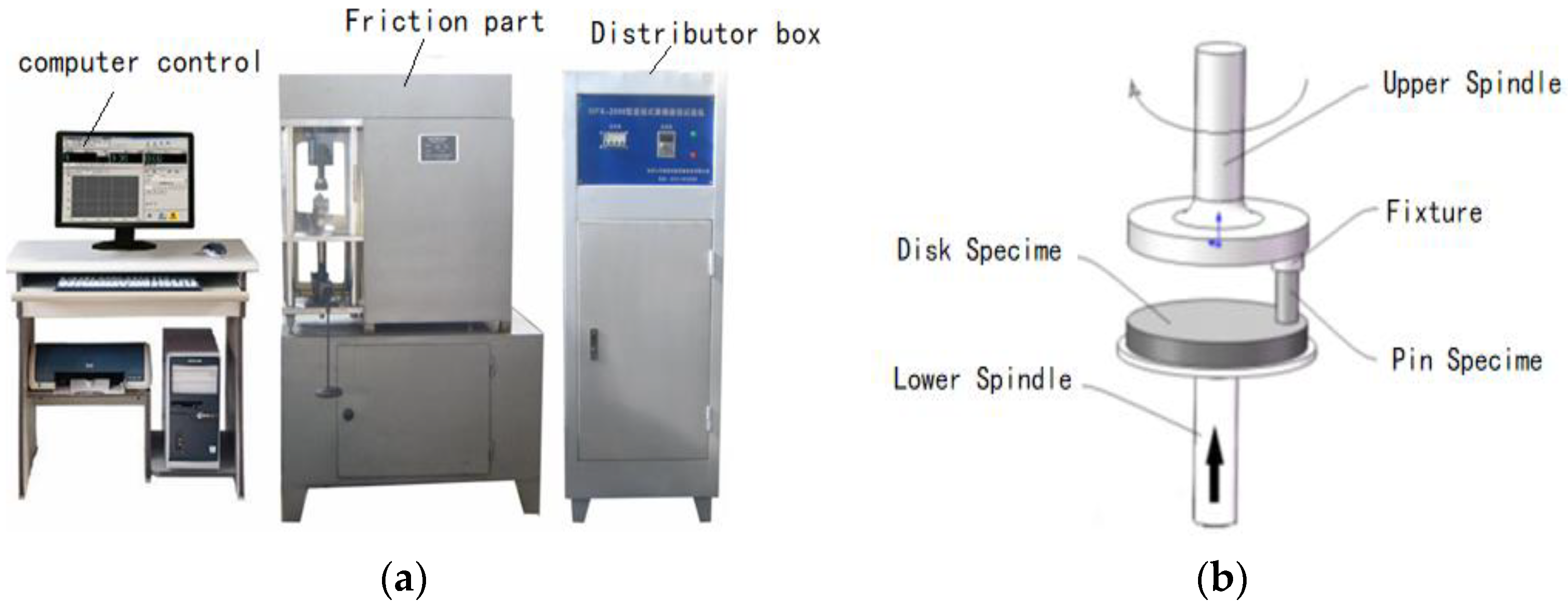
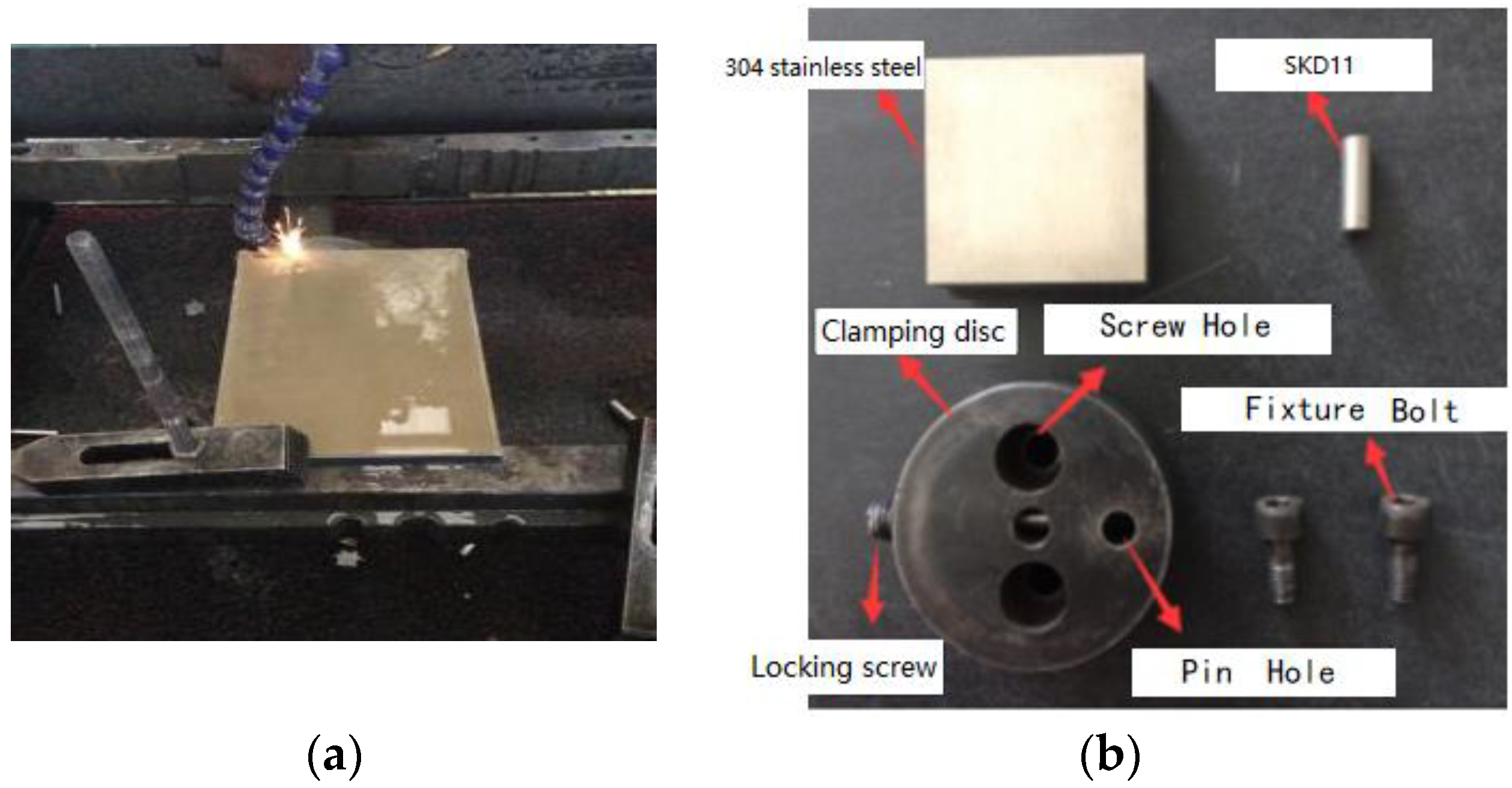
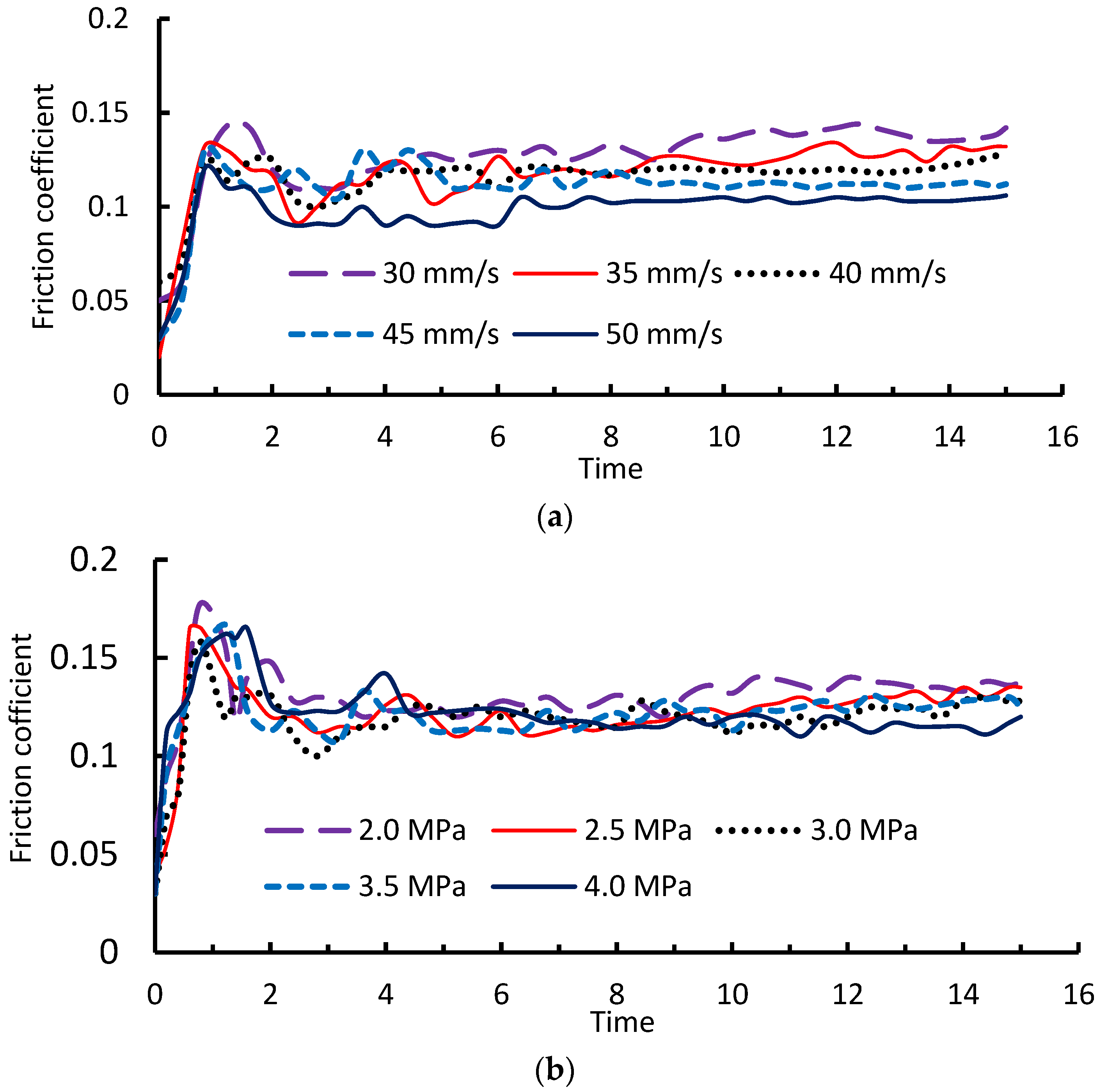
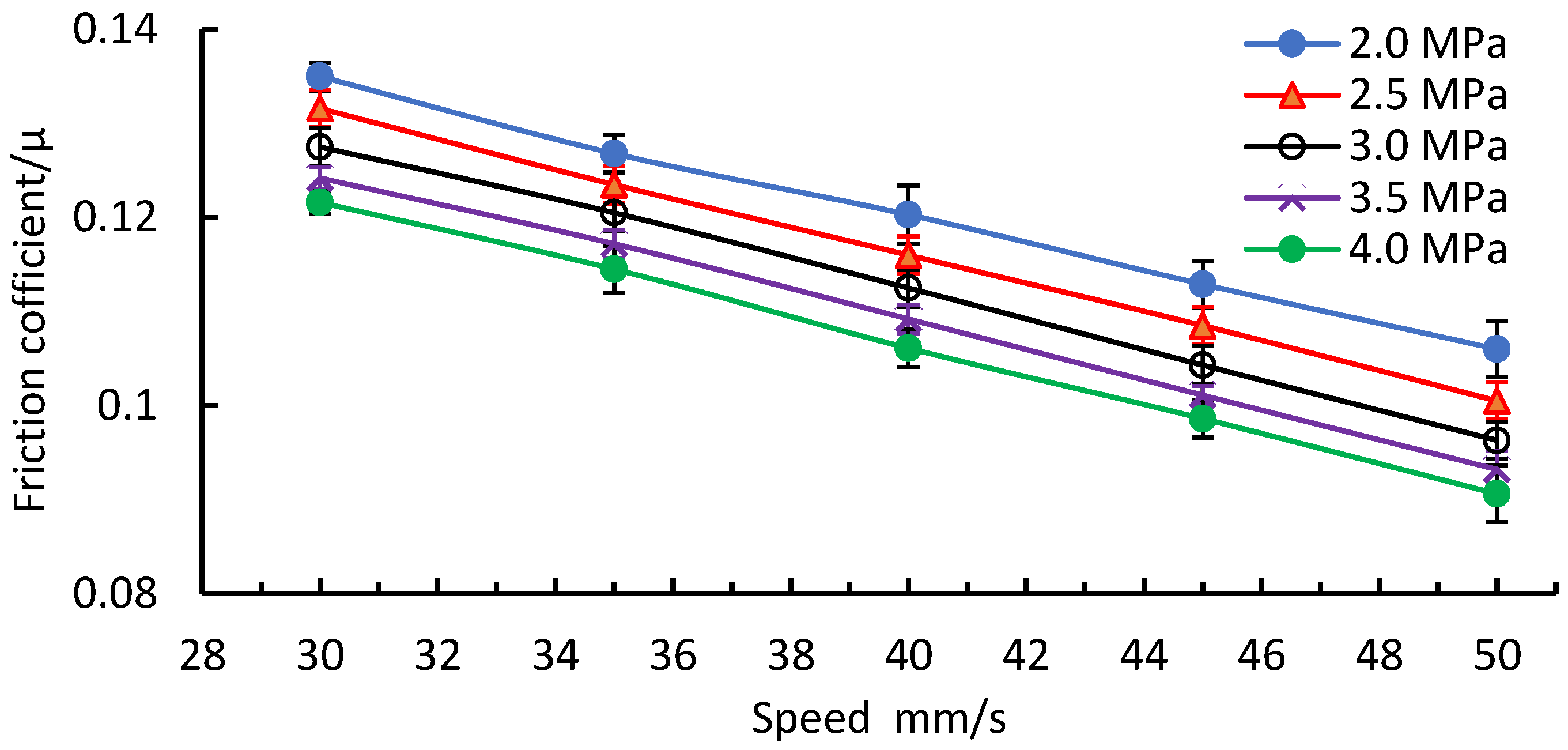


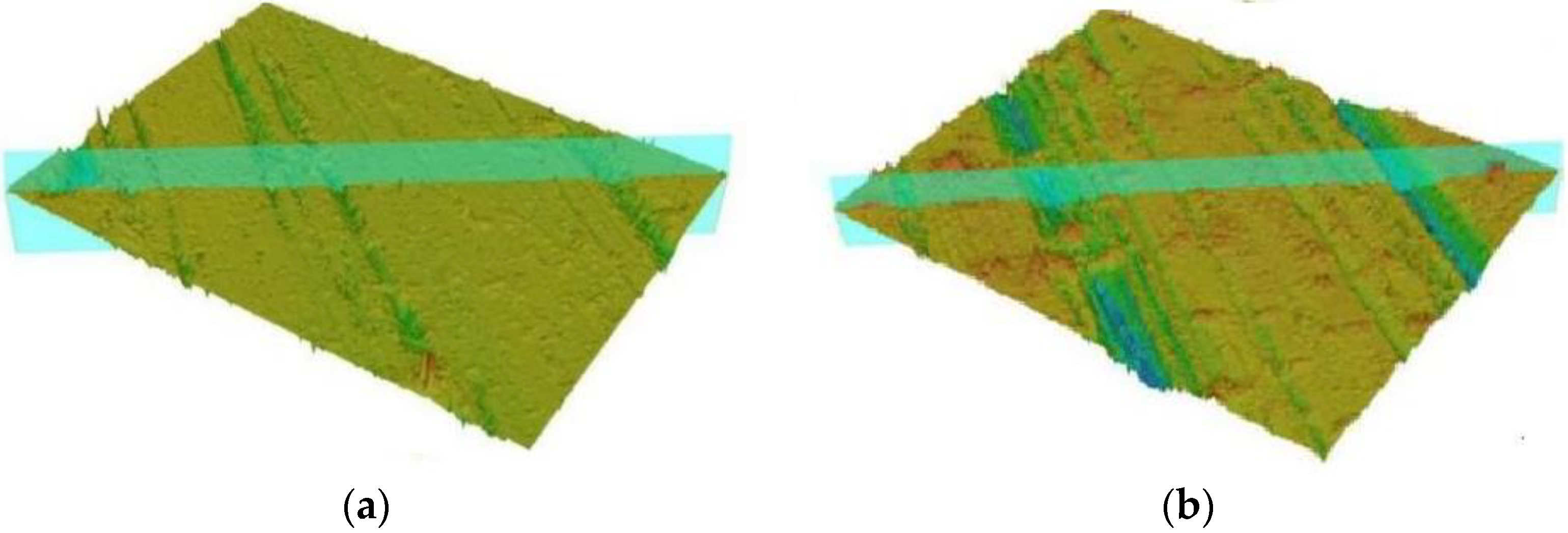
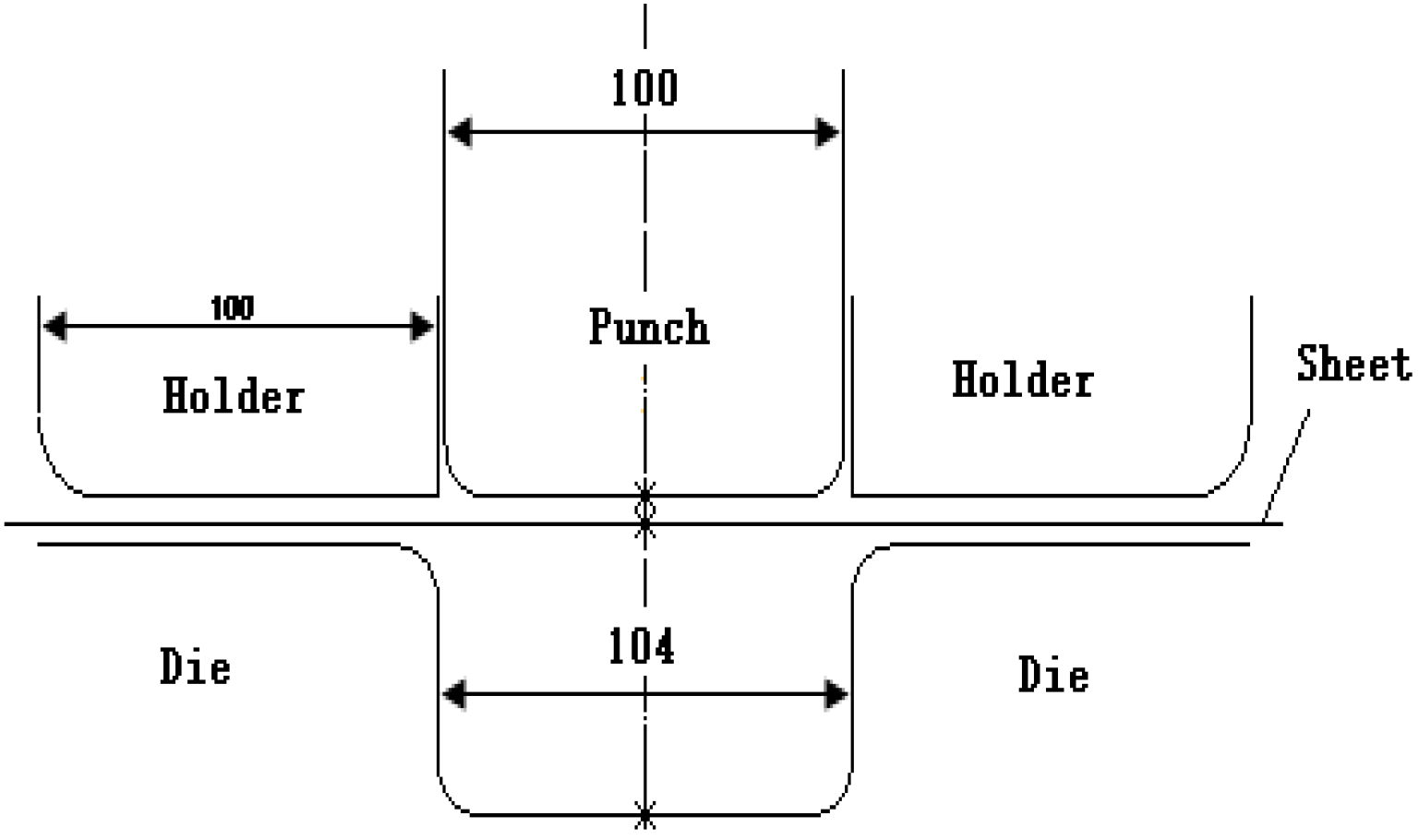
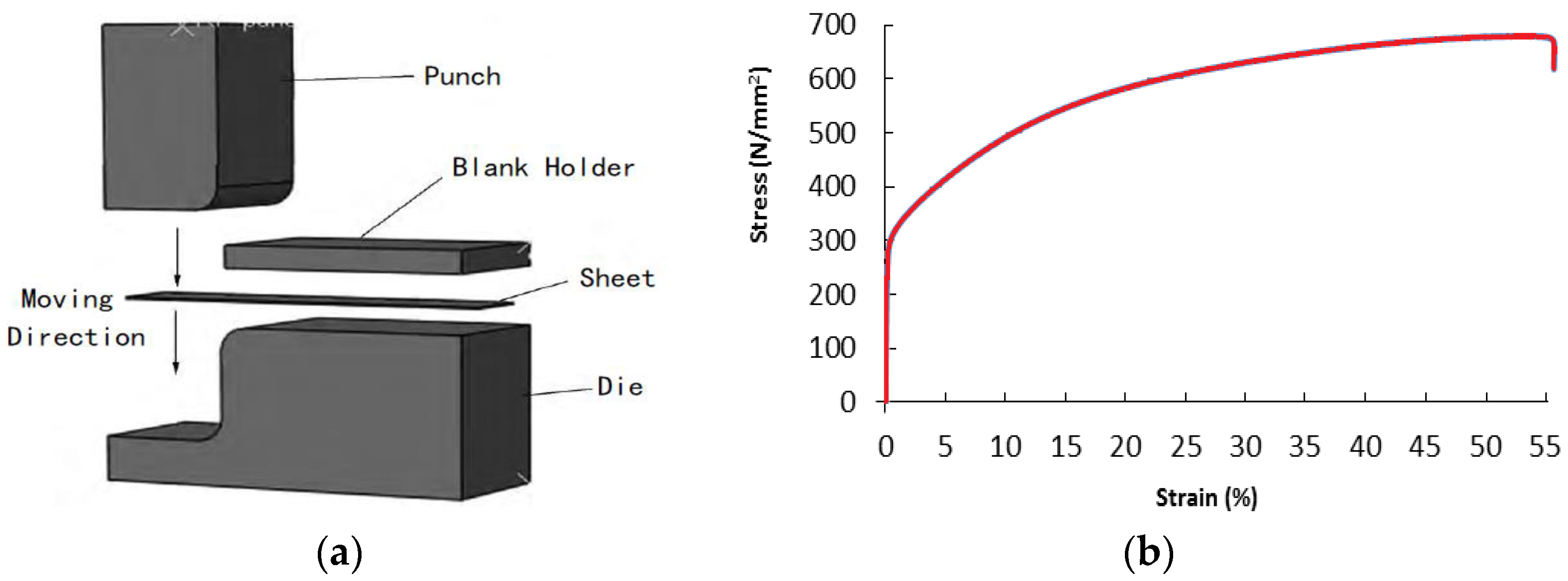

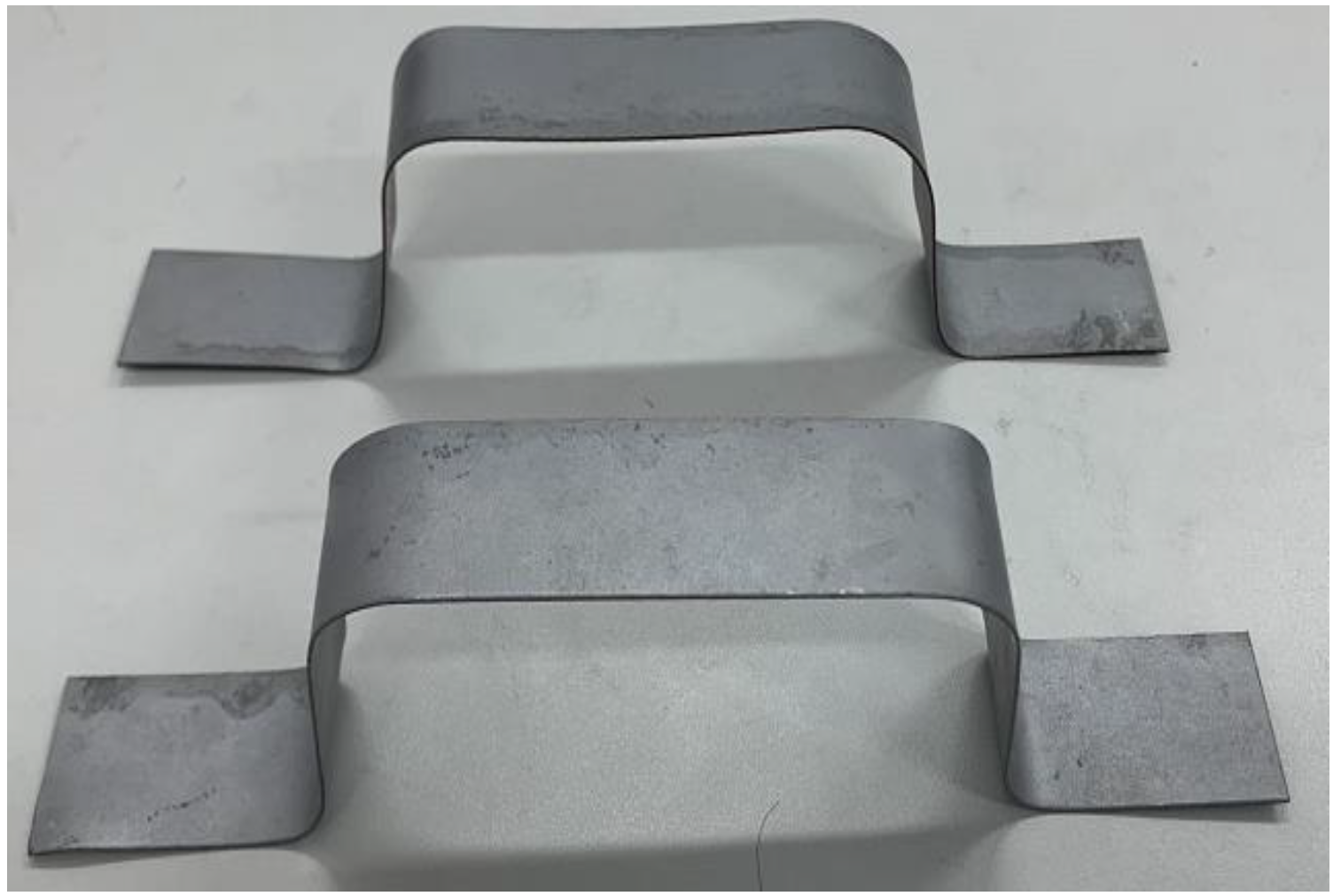



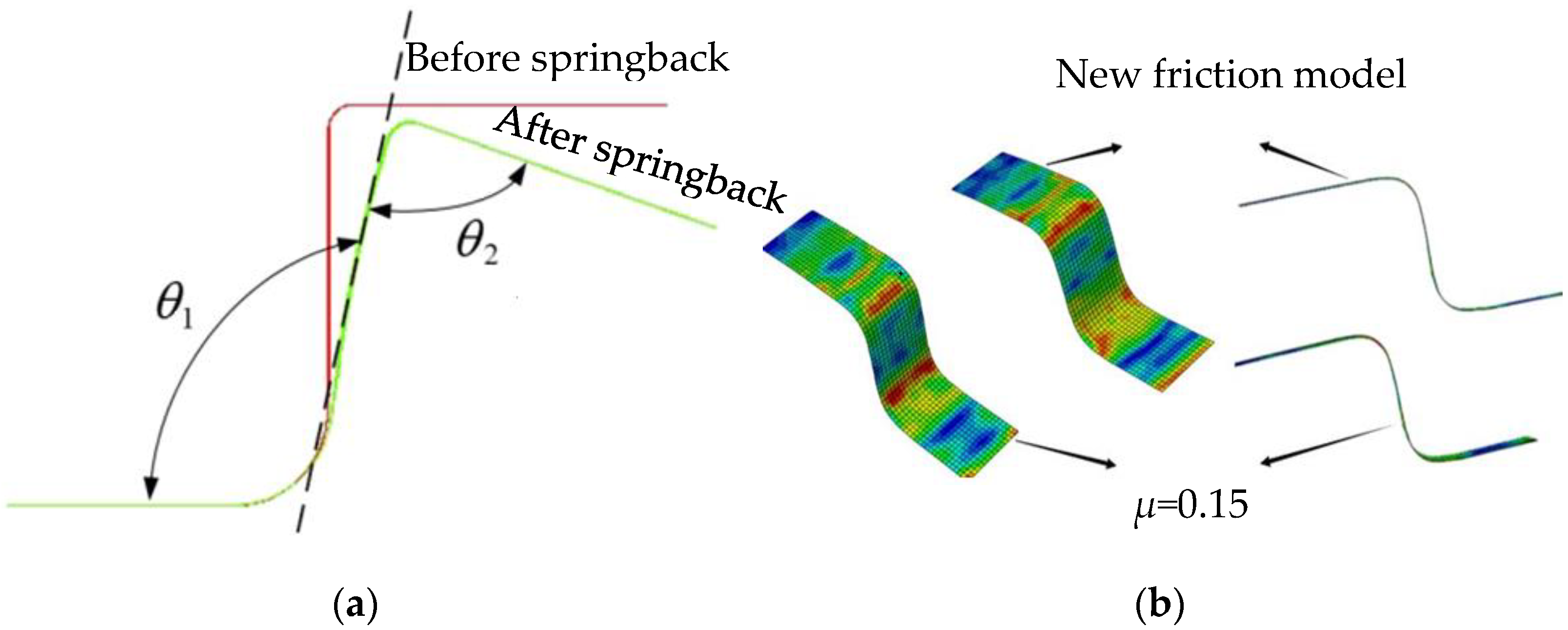

| Name | Mn | C | Cr | Si | Ni | P | S | Cr | Mo | V | Fe |
|---|---|---|---|---|---|---|---|---|---|---|---|
| 304 stainless | 0.79 | 0.50 | 17.92 | 0.56 | 8.77 | 0. 29 | 0.009 | - | - | - | Bal. |
| SKD11 | 0.50 | 0. 40 | 12.0 | 0. 40 | - | - | - | 12.0 | 1. 0 | 0. 30 | Bal. |
| Springback Angle (°) | a (°) | b (°) |
|---|---|---|
| Actual value | 10.2 | 7.8 |
| μ = 0.05 | 13.2 (Error: 29.41%) | 9.8 (Error: 25.64%) |
| μ = 0.15 | 7.8 (Error: −23.53%) | 6.5 (Error: −21.37%) |
| μ = 0.1 | 12.5 (Error: 22.55%) | 9.3 (Error: 19.23%) |
| New friction model | 10.9 (Error: 6.86%) | 8.2 (Error: 5.13%) |
Publisher’s Note: MDPI stays neutral with regard to jurisdictional claims in published maps and institutional affiliations. |
© 2022 by the authors. Licensee MDPI, Basel, Switzerland. This article is an open access article distributed under the terms and conditions of the Creative Commons Attribution (CC BY) license (https://creativecommons.org/licenses/by/4.0/).
Share and Cite
Xia, J.; Zhao, J.; Dou, S. A Novel Model Developed for Frictional Characteristics Analysis of Axial Symmetric Parts. Symmetry 2022, 14, 842. https://doi.org/10.3390/sym14050842
Xia J, Zhao J, Dou S. A Novel Model Developed for Frictional Characteristics Analysis of Axial Symmetric Parts. Symmetry. 2022; 14(5):842. https://doi.org/10.3390/sym14050842
Chicago/Turabian StyleXia, Jiansheng, Jun Zhao, and Shasha Dou. 2022. "A Novel Model Developed for Frictional Characteristics Analysis of Axial Symmetric Parts" Symmetry 14, no. 5: 842. https://doi.org/10.3390/sym14050842






